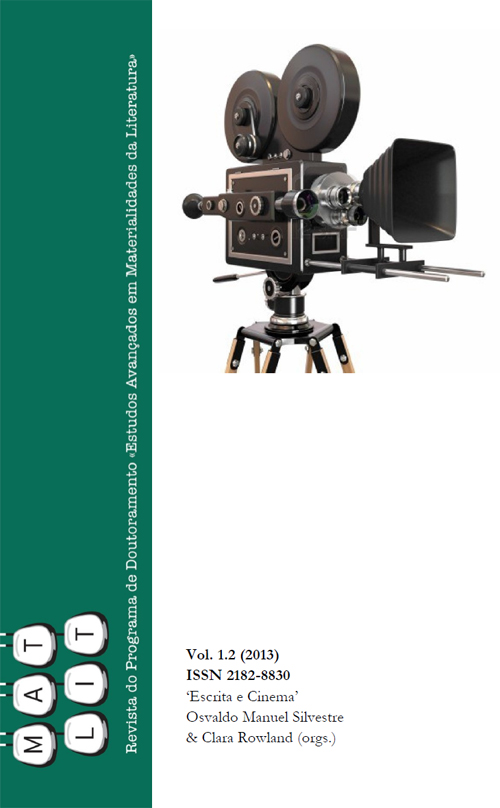Vol. 1 Núm. 2 (2013): Escrita e Cinema

Na sequência final de Un chien andalou (1929) de Luís Buñuel, o casal passeia pela praia de mãos dadas, no que seria um Happy End perfeito, não fora o último plano, situado na Primavera seguinte, em que do casal parecem restar apenas reproduções em cartão, arruinadas pela natureza. O filme termina pois em pleno imaginário romanesco (melodrama, final duplo, falso happy end), o que ajuda a perceber que, como nota Robert Short, o surrealismo não abandonou a narrativa nem virou costas à «arte de massas», aliás uma boa definição para o cinema nascente, quer em Hollywood quer em boa parte da Europa de então. Un chien andalou, lembre-se, começa com o intertítulo «Il était une fois», e o filme afasta-se das tentativas anteriores da vanguarda Dada ou surrealista no cinema (Man Ray, Desnos, Artaud) justamente por não destruir a produtividade da ideia de «contar uma história». O problema reside aqui mesmo, pois ao recusar a pura experimentação formal que definira até aí a vanguarda, Buñuel não recupera porém aquela versão oitocentista da literatura enquanto «arte de contar histórias para a burguesia», versão contra a qual se virá a erguer o movimento moderno. Lembremos aquele disclaimer de Mallarmé, figura maior da crítica da representação que alimentará a literatura moderna, segundo o qual versos não se fazem com ideias mas com palavras (ou aqueloutro de Valéry, incapaz de escrever frases como «A marquesa saiu às cinco horas»).
O que fica então da narrativa em Un chien andalou? A sabotagem do mecanismo da causa-efeito e, logo, da sequência narrativa, mas ao mesmo tempo a narrativa como teleologia (ou pulsão). Assim como da literatura fica um certo número de tropos – acima de todos a metonímia que nos dá a ver o trabalho do inconsciente – e um famoso efeito de assinatura produzido logo a abrir pelo autor-realizador ele-mesmo por meio de uma navalha de barba. A complexidade com que o filme inaugural de Buñuel aborda as relações entre escrita e literatura, de um lado, e cinema, do outro, situa-se pois muito para lá do quadro tradicional em que os estudos literários conceptualizam essa relação, quase sempre sob a égide da figura da «adaptação», com todas as suas noções de referência (precedência, traduzibilidade, fidelidade, etc.). Inversamente, é possível afirmar que o cinema tende a confundir a literatura, e em especial o romance, com a história, esquecendo ou menorizando as «palavras», para regressar a Mallarmé, e optando pelas «ideias». Contudo, não há cinema, mesmo no precedente histórico do mudo, sem escrita, da pré-produção (o argumento) à pós-produção (que pode ir da crítica à novelização do argumento, como ocorre em vários dos filmes UFA de Fritz Lang ou nos de Spielberg e George Lucas, mas também nos livros que o Godard tardio edita a partir dos textos – ou melhor: das frases – que escreve para os seus filmes) ou ainda à inscrição no corpo do filme de subtítulos, separadores, citações, etc. (pense-se nos casos maiores de, de novo, Godard, ou Greenaway). E há toda uma tipologia de «inscrições» da escrita em filmes: a produzida pela carta, pelo diário ou pela poesia, no momento da escrita ou da leitura, em tratamento ficcional ou documental. Refira-se ainda um género tão singular como o «filme ensaio», cuja ascendência literária é denunciada logo na sua designação, e cujo procedimento formal herda a inquirição do ensaio enquanto escrita híbrida e epistemologicamente vacilante.
O Volume 1.2 de MATLIT aborda uma gama alargada de ocorrências da materialidade e reflexividade da escrita no cinema, tentando reflectir sobre (i) a relação entre escrita e imagem fílmica, as possibilidades de descrição/ tradução mútua e os limites semióticos dessa descrição; (ii) a escrita no cinema, como tema e como inscrição; (iii) o cinema como escrita e linguagem e a linguagem e a escrita como analogias dos processos de significação no cinema; (iv) a forma como a materialidade da escrita no cinema nos ajuda a pensar a literatura como inscrição mais do que como ontologia. Este segundo número resulta de um esforço conjunto entre o Programa de Doutoramento «Estudos Avançados em Materialidades da Literatura» e o projecto FCT «Falso Movimento – Estudos sobre Escrita e Cinema» (PTDC/CLE-LLI/ 120211/2010).
Osvaldo Manuel Silvestre (CLP, Universidade de Coimbra)
Clara Rowland (CEC, Universidade de Lisboa)













